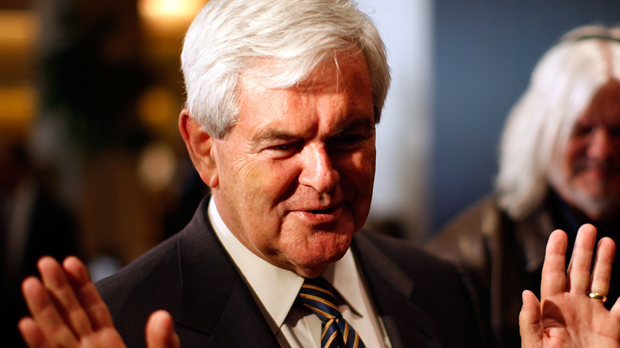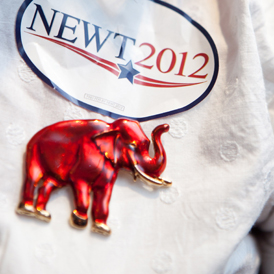The curious case of Newt Gingrich and the spambots
He has presidential ambitions and a Twitter following to match, but US politician Newt Gingrich is fighting allegations his fanbase is fake. Channel 4 News investigates the claims and counter-claims.

Forget the US debt ceiling nail-biter, another drama has been rippling around Washington DC in the last few days: “followergate”.
Veteran politician Newt Gingrich is a popular man on social network Twitter, or so it would seem. Gingrich, a former Speaker in the House of Representatives, is campaigning to become the Republican nominee in the 2012 presidential election.
He recently proclaimed: “I have six times as many Twitter followers as all the other candidates combined.”
But claims and counter-claims have been circulating over who these followers really are. More specifically, are they all human?
Website Gawker kicked off the fuss by quoting an anonymous former employee of Mr Gingrich who alleged that the 68-year-old “bought” some of his 1.3 million followers.
The source said: “About 80 per cent of those accounts are inactive or are dummy accounts created by various “follow agencies,” another 10 per cent are real people who are part of a network of folks who follow others back and are paying for followers themselves…
“The remaining 10 per cent may, in fact, be real, sentient people who happen to like Newt Gingrich.”
In response to the Gawker claims, Gingrich campaign spokesman RC Hammond tweeted: “@newtgingrich‘s 1.3 million followers are legitimate. @Gawker‘s “source” is not. Story untrue.” In a later tweet he added: “Report is #rude #unfounded & #erroneous.”

But the debate over “followergate” has proved irresistible to political opponents, Twitter watchers and, unsurprisingly, companies which provide Twitter analysis services.
New York data-crunchers peekyou.com trawled Gingrich’s followers and claimed to find some interesting results.
The search firm calculates a figure it calls a “consumer ratio” – the percentage of a Twitter audience that can be identified as a “consumer” or “voter” as opposed to a business, anonymous or spam account. In other words a “human test”.
For Gingrich’s 1.3m followers, they calculated this figure at just 8 per cent. To flip that around, their statistics suggest that a whopping 92 per cent of his Twitter fanbase could be fake. Again, the claim has been rubbished by pro-Gingrich voices.
Gingrich v Obama v Snow
Channel 4 News has carried out its own “followergate” analysis, using the Twitter tool TwitBlock.org.
The service allows users to scan their Twitter followers to see which ones are “most likely” to be junk accounts. The site explains: “The most significant indicators we observe are aggressive following tactics, how much an account is ignored, whether the account has been blocked by other TwitBlock users, and whether many other accounts have the same profile picture.”
So how did our candidates fare? TwitBlock trawled through the most recent 3000 followers of Newt Gingrich, Barack Obama and our own presenter Jon Snow to work out an approximate percentage of suspected phoney accounts. This is what the three scans found:
@newtgingrich (1.3m followers) = 7.9% suspected fakes
@BarackObama (9.4m followers) = 2.2%
@jonsnowC4 (107,000 followers) = 2.7%
The figures show that Gingrich has significantly more suspected “fake” followers than Obama and Snow, but nowhere near the spambot tally calculated by peekyou.com. Interestingly, Obama has the least suspected phoney fans, despite having a mammoth 9.4m followers.
The TwitBlock software is built by web developer Tim Whitlock who told us: “I don’t assume [Gingrich] is doing anything particular to attract spam, rather that he’s not doing enough to attract humans.”
Anyone who did this would be extremely stupid and would presumably be exposed as an idiot. Professor Keith Ewing
But Josh Gosser who set up the Team Gingrich blog thinks the opposite. He explained why he thinks Gingrich is so big on Twitter.
He told Channel 4 News: “He doesn’t just use it as a way to get out press releases; he says things in a way that fits the platform of Twitter very well.
“Newt will actually reply to people on Twitter, which is very unusual for someone running for any office, let alone president.”
Will we see a UK followergate?
The 2010 general election saw the arrival of Twitter as a campaign tool with hundreds of MPs swapping the soapbox for the @ box. So what would happen if a leading UK candidate were accused of falsely inflating their following?
Not a great deal, on the face of it. The Electoral Commission looks at campaign spending, so if an MP paid a consultancy firm to help boost their follower count during the campaign period (the run-up to an election) they would need to declare receipts. However in terms of the ethics of the service provider, the commission would not get involved.
Election fraud covers serious transgressions like bribery or the stealing of ballot boxes. But “making yourself appear popular” would not be deemed an offence. Indeed, it could be argued politicians have been doing this long before the digital age.

But political funding expert Keith Ewing, Professor of Public Law at King’s College London, told Channel 4 News although Twitter tricks “might not be unlawful” it would certainly be a risky business for someone running for election.
He said: “Anyone who did this would be extremely stupid and would presumably be exposed as an idiot, and would have to answer for his or her conduct to his or her electors.”
He added that social media activity by politicians could and should be regulated in the future.
“It is just a different way of turning old tricks, albeit usually much cheaper.
“But that is a case for saying that we need a proper regulatory agency trusted with powers to move quickly to adapt the election rules to new circumstances.
“The Representation of the People Act (RPA) is a joke and still bears its Victorian hallmark, from the way it is written, to the slow speed at which it can be changed, to its content.
“The issue in the Gingrich allegations is an example of a wider problem not unique to Twitter, namely are the candidates making false claims about the true nature of their support?”
Rise of the spambot
With more Twitter accounts popping up every hour of every day, it would seem the battle to separate real from fake can only get more complex. But there are restrictions which keep the spammers in check. For example, did you know there are limits on how many other accounts a Twitter user can follow?
Paul Sawers, UK editor of The Next Web, explains: “Each Twitter account can follow 2,000 users without any problems. Over this number, there are restrictions in place to the number of additional accounts people can follow. The exact number is different for each account and is based on the ratio of followers to following. Unfortunately, Twitter doesn’t publish what this ratio is.”
He told Channel 4 News: “We don’t know an exact percentage of fake Twitter users, but it’s likely to be hundreds of thousands if not millions, given the ease with which they can be set-up.
“And it depends what you mean by ‘fake’ too. There are many accounts that pretend to represent an organisation or celebrity for example, but this kind of ‘Twitterjacking’ is typically not tolerated by Twitter, and they often intervene…
“Lots of people will have a Twitter account that they have set up to follow a handful of people, but they may have no desire to upload their own profile photo or send tweets themselves. So it’s not always easy to know what accounts are fake and what are real.
“Twitter has 200m accounts, it’s not practical to monitor everything that’s going on.”
-
Latest news
-
India’s ‘YouTube election’: Influencers enlisted to mobilise youth vote6m

-
Putin denies plans to capture Ukrainian city of Kharkiv3m

-
Plaid Cymru ends co-operation agreement with Welsh Labour government4m

-
Infected blood scandal: Government was warned years before taking action6m

-
Displaced in Gaza have to ‘start from Zero’ many times over, says Gaza NGO director3m

-




